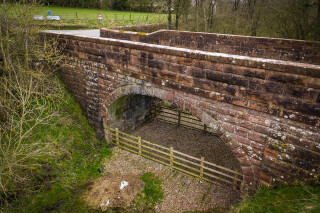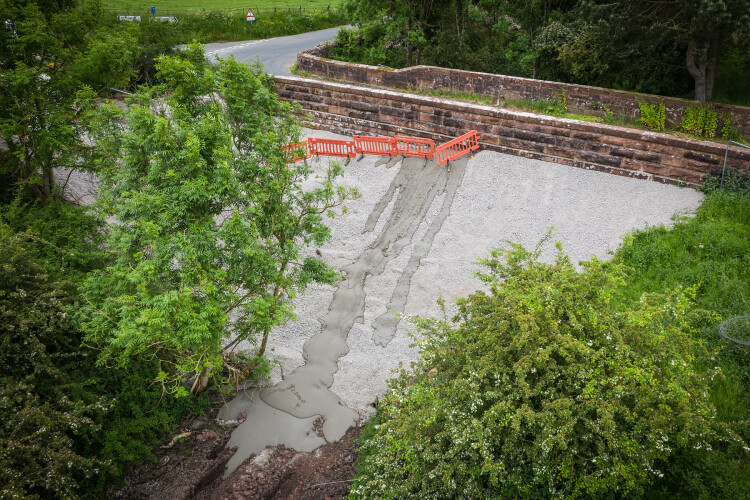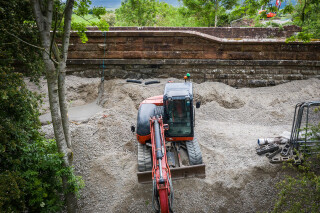Highways England has been accused of vandalism for covering an old rail bridge with hundreds of tonnes of aggregate and concrete.
The HRE Group, an alliance of engineers, sustainable transport advocates and greenway developers, says that the infilling of Great Musgrave bridge in Cumbria was an unnecessary waste of money.
They also say that the decision by Highways England has wrecked hopes of linking the Eden Valley and Stainmore railways to create an 11-mile tourist line between Appleby and Kirkby Stephen.
However, Highways England says that it has ‘preserved the structure’ and will remove all the infill for free if the heritage rail plans ever come to anything.
Highways England is custodian of the Historical Railways Estate, responsible for 3,100 disused structures on behalf of the Department for Transport. Dozens of its bridges and tunnels are earmarked for infilling or demolition over the next five years as part of an asset management programme, despite many of them being needed for proposed cycle routes, reopened railways or heritage line extensions.
Great Musgrave bridge in Cumbria spanned a five-mile section of trackbed which the Eden Valley and Stainmore railways hope to restore. But their plans have been thrown into doubt after Highways England compacted aggregate around the structure and filled the arch with concrete. Only its parapets are now visible.
Highways England says: “Infilling or demolition is only considered when structures have been assessed as unsafe. We don’t demolish or infill a structure without first determining if there’s a viable interest, from a local authority or another organisation.”

Highways England historical railways estate director Richard Marshall said that the work was necessary. “No weight restriction was implemented on Great Musgrave bridge, meaning vehicles of any weight could cross the structure. The support provided by infilling the arch removes the risk of the bridge deck from failing, meaning a weight limit is no longer required and the bridge will remain safe for everyone who wishes to use it.”

He added: “The land along the route required for establishing a heritage railway line contains several different owners and there is no route across the River Eden as the railway bridge was demolished over thirty years ago. Through our work we have preserved the structure. If land and river crossing issues get resolved, then we would be delighted to work with any rail groups and the local authority to remove the infill at no cost to them.”
However, a report by The HRE Group found that there was no engineering, public safety or financial justification for the infilling scheme. Although a technical assessment in 1998 had rated the structure as strong enough only to carry 17 tonnes, £5,000 of repointing work would have increased its capacity to 40 tonnes, according to HRE Group’s assessment, while infilling cost £124,000. The narrow road crossing the bridge is very lightly used and traffic is constrained by a nearby 18-tonne weight restriction, two low railway bridges, three humped crossings of the River Eden and several sharp bends.
Graeme Bickerdike, a member of The HRE Group, said: “The evidence demonstrates that the bridge was in good order, showing no signs of overloading. It had a few minor defects like any other 160-year-old structure, but nothing that warranted any more than modest repair.
“What happened at Great Musgrave was opportunistic work to get rid of what Highways England saw as a liability, empowered by Eden District Council telling them that they didn’t require planning permission. But the company didn’t recognise – and probably didn’t care – that the bridge was viewed as an asset by the two railways.
“As we meet our obligation to develop more sustainable transport routes, the value of the UK’s disused railway network increases in value. But Highways England continues to view the Historical Railways Estate as a millstone around its neck. That culture must be challenged and changed.”
Mike Thompson, project manager for the Stainmore Railway Company, said: “It’s been a kick in the teeth for us. We knew nothing about the infilling until after the work had started. Highways England consulted their partners in Sustrans and the Railway Heritage Trust - who have no interest in the route and therefore expressed no objections – but they made no contact with the two organisations who had known and longstanding intentions to reuse the bridge.
“They’ve told the media – but not us – that they will remove the infill free-of-charge if our reconnection plan moves forward. That would burden the taxpayer with another huge bill. And how would we enforce this pledge when the managers who’ve made it have moved on to other things?
“This work was unwarranted and destructive. Why didn’t they carry out the repairs recommended by their inspector? And to suggest that they have ‘preserved’ the bridge just adds insult to injury. They are completely out of touch. Anyone involved in the care of historic buildings and structures would only recognise this as an act of vandalism.”
Got a story? Email news@theconstructionindex.co.uk




